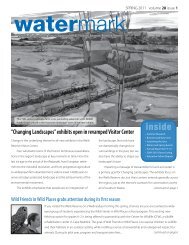Management Plan - National Estuarine Research Reserve System
Management Plan - National Estuarine Research Reserve System
Management Plan - National Estuarine Research Reserve System
You also want an ePaper? Increase the reach of your titles
YUMPU automatically turns print PDFs into web optimized ePapers that Google loves.
XII. <strong>Reserve</strong> Boundary and Acquisition <strong>Plan</strong>IntroductionThe Wells <strong>National</strong> <strong>Estuarine</strong> <strong>Research</strong> <strong>Reserve</strong>advocates a comprehensive approach to protectingresources, providing stable environmentsfor research and education, and broadening the<strong>Reserve</strong>’s representation of ecosystems. As part ofthis effort, <strong>Reserve</strong> staff has mapped all land withinthe Little River, Webhannet River, and OgunquitRiver watersheds; worked within local communitiesto develop strategies to protect land and water; andidentified and prioritized land suitable for protectionby the Wells <strong>Reserve</strong> and its partners.The Wells <strong>Reserve</strong>’s objectives for conservation,research, education, and stewardship are most easilymet when the <strong>Reserve</strong> <strong>Management</strong> Authority orone of its represented entities directly manages atract of land. This level of control is possible forlands within its “<strong>Reserve</strong> boundary.”Not all lands important for conservation lie withinthe <strong>Reserve</strong> boundary. The watersheds of rivers andstreams flowing into the <strong>Reserve</strong>’s estuaries areunder considerable development pressure. Rapidgrowth could threaten the functions of estuarineecosystems by fragmenting habitat, damagingwetlands, and degrading water quality upstream ofthe <strong>Reserve</strong>. The Wells <strong>Reserve</strong> must help conservecritical resources outside the <strong>Reserve</strong> boundary toavoid negative impacts on the estuarine resourceswithin its boundary. The area in which the Wells<strong>Reserve</strong> will directly and actively participate in landconservation efforts with the goal of incorporatingprotected lands into the <strong>Reserve</strong> and managing theproperties is defined by its “acquisition boundary.”This chapter proposes to expand both the <strong>Reserve</strong>boundary and the acquisition boundary. This sectionalso describes priorities and procedures the<strong>Reserve</strong> will use to acquire in-holdings within the<strong>Reserve</strong>’s perimeter; to acquire large contiguoustracts adjacent to <strong>Reserve</strong> lands; and to protecttracts within watersheds upstream of the estuaries,especially those tracts that border streams, tributaries,and wetlands feeding estuarine and riparianhabitats.As part of its stewardship mission, the Wells<strong>Reserve</strong> works with land conservation organizationsin coastal zone communities of southernMaine to conserve key coastal and estuarine landsoutside its recognized boundary. The Coastal and<strong>Estuarine</strong> Land Conservation Program (CELCP)offers the <strong>Reserve</strong> and its partners an opportunityto protect important coastal and estuarine areasthat have significant conservation and ecologicalvalues and will offer the <strong>Reserve</strong> additional opportunitiesfor research and education (discussed in theStewardship <strong>Plan</strong> section).Objective and StrategiesObjectiveConserve lands necessary to protect <strong>Reserve</strong>resources, ensure a stable environment for researchand education, and broaden the <strong>Reserve</strong>’s ecologicaldiversity by encompassing additional coastal watershedareas.Strategies◊ Identify high-priority properties within the<strong>Reserve</strong>’s boundary and discuss with landownersthe value and benefits of long-termconservation.◊◊◊Work with local, federal, and state conservationpartners to conserve priority in-holdingparcels within the Wells <strong>Reserve</strong> boundaryand high-value parcels within the <strong>Reserve</strong>’swatershed areas.Work with partners to prioritize lands withinthe watersheds of the <strong>Reserve</strong> that lie outsidethe NOAA-recognized boundary (Section315), and help to secure CELCP funding forprojects.Increase public awareness of the value of landconservation to people, communities andwildlife.98 Wells <strong>National</strong> <strong>Estuarine</strong> <strong>Research</strong> <strong>Reserve</strong>




